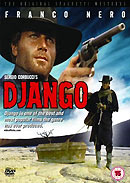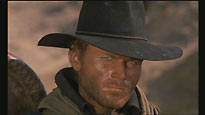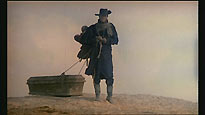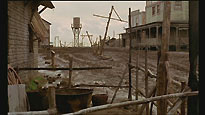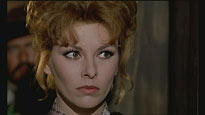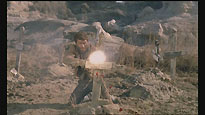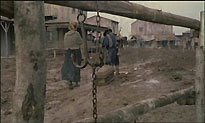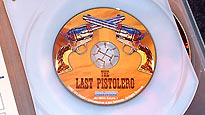|
DJANGO Region 2 Edition, reviewed by Mark Frost Director: Sergio CorbucciFeaturing: Franco Nero, José Bódalo, Loredana Nusciak, Ángel Álvarez
THE FILM A stranger, Django (Franco Nero), walks into a desolate town accompanied by a prostitute whose life he has just saved, dragging a mysterious coffin behind him. Once there, he raises eyebrows amongst the rival gangs in the town – the racist confederates led by the megalomaniac Major Jackson, and General Rodriguez’s band of Mexican revolutionaries. Django begins to play the gangs off against each other whilst gradually his real motivations are revealed. The Westerns made in America in the 1940’s and 50’s were typically bright and optimistic affairs. A lone cowboy returning home to fight for his family, a mercenary who sees it in his heart to put people over money – with few exceptions you could always bet that the hero would turn good by the resolution and the film would conclude on a happy note. This outlook reflected American society and the purveying attitude to keep building, keep improving and remain positive. In 1964 A Fistful of Dollars was made, and the mood of the Italian people was imprinted all over it. Pessimism, cynicism and general disdain. A Fistful of Dollars was certainly bleak in tone, but the look of the town and people was still one hundred percent American. Django’s pessimistic Italian roots were expressed visually – the town in the film is a forlorn shell, with the main street a literal mudbath. The residents are completely worthless creatures, looking flea-bitten, downtrodden and without hope. The opening of Django is one of the most enduring and iconic, the image of Django dragging his own coffin through deep mud, struggling to scale a hill. Its all there – the air of mystery around ‘the stranger’ represented by hidden face and the tattered civil war outfit, and the hero’s unknown back-story, signified by the coffin he is pulling. Django quickly reveals itself to be yet another derivative of the ‘servant of two masters’ plot employed by A Fistful of Dollars (by way of Yojimbo). Corbucci also mixes in a fair bit of the For A Few Dollars More story. Django differs from Fistful and the average Spaghetti of the time by having the main characters motivations revolve around something other than money - here it is revenge. Although not exactly original for film in general, it is refreshing to see a Spaghetti Western where the main character actually has a real stake in the story. Somewhat unrecognisable from his later image, Franco Nero is superb as the title character. Sadly, his performance is almost suffocated by the horrendous English dubbing, which is some of the worst I’ve ever heard – his voice is too high pitched and mind-numbingly bland. Corbucci gives Nero the usual western motifs to act out at first, but as the plot becomes more complicated, Nero’s performance rises to the challenge. A review of Django is not complete without discussing its violence, and some of the scenes still shock today. Its amazing to think that a shot of a man having his ear cut off and being forced to eat it could have existed in 1966, considering how much controversy a similar scene in 1991’s Reservoir Dogs caused. But the sequence is in good company alongside the infamous street massacre, the horses being led over a man’s hands, and the target practice using Mexican villagers (inspiring a similar scene in the 1968 Yul Brynner film Villa Rides). This is a remarkably confident film for so early on in the Spaghetti boom, matching the Leone pictures in popularity. For what was essentially an imitator itself, Django was followed by over thirty sequels; most of them ordinary Westerns re-titled to cash in on its success. Standouts include Django the Bastard, from which High Plains Drifter lifted the story, and the insane, a deranged, ultra-violent, psychedelic experience which Argent have also released. As a film, Django is not perfect. It loses a lot of steam in the middle, causing the viewers’ attention to wane somewhat. And it more or less just leisurely canters to the finale, itself an anti-climax. The end would be perfectly adequate in most Westerns, but the first third promises so much that it can’t possible keep the pace till the end.
THE DVD PictureI was pleasantly surprised by Django after the relative disappointment of Argent’s Keoma. The 1.66:1 presentation is a huge improvement over previous VHS releases, the image has good contrast with a pleasingly sharp image, at an average of 7.46mb/s. It cannot compete with the R1 Blue Underground release, but extensive re-mastering was undertaken on that disc so it is no surprise. Extensive print damage is evident, but I’m afraid that is par for the course for this type of film - and the Blue Underground suffers from the same problem. This Argent release is far from perfect – the colours are washed out compared to the vibrant Blue Underground, and it will certainly never be a demo disc to show friends, but we should be thankful it has been released in this country. The picture appears to be slightly cropped to fit into the anamorphic 16:9 image - which some people may not notice - but I found it very annoying. SoundThe film is presented in mono at 192kbps. It’s an acceptable, clear track which does nothing wrong, but the Argent disc gets the biggest cross against its name here – the Blue Underground disc contains the original Italian soundtrack alongside the English dub, which turns Django into a wholly better film: more serious, deep and meaningful, with less of the glib, tacky lines that the English translation is saddled with.
THE BONUS MATERIAL Introduction by Alex Cox (12m 10s) The ever-reliable Alex Cox delivers an informative introduction to the feature (which, the menus handily inform you, contain spoilers). Cox doesn’t impart anything that will change the way you view the film, but the man certainly knows his stuff. Interview with Franco Nero (11m 59s) The fantastic Franco Nero takes us through his experiences making the film, including some revealing anecdotes. The production on these interviews is cheap, but it doesn’t really matter when it is the instantly likeable Nero talking. My only complaint is that it is too short.
SUMMARY Django is a very important film in the history of spaghetti westerns, contributing a great deal to the movement and a noticeable shift in the tone and attitude of film in general. Argent have given us a solid release, which, unfortunately for them, loses out to the R1 Blue Underground in terms of picture quality and audio presentation. It should also be noted that the Blue Underground DVD release currently includes a free disc of the wonderful 2002 short film, The Last Pistolero – an opportunity to see Franco Nero back in a cowboy hat - if only for ten minutes. |
|||||||||||||||||||


